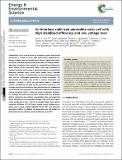An interface stabilized perovskite solar cell with high stabilized efficiency and low voltage loss
Author(s)
Yoo, Jason Jungwan; Wieghold, Sarah; Sponseller, Melany C.; Chua, Matthew R.; Bertram, Sophie N.; Hartono, Noor Titan Putri; Tresback, Jason S.; Hansen, Eric C.; Correa-Baena, Juan-Pablo; Bulovic, Vladimir; Buonassisi, Tonio; Shin, Seong Sik; Bawendi, Moungi G.; ... Show more Show less
Downloadc9ee00751b.pdf (4.309Mb)
Terms of use
Metadata
Show full item recordAbstract
Stabilization of the crystal phase of inorganic/organic lead halide perovskites is critical for their high performance optoelectronic devices. However, due to the highly ionic nature of perovskite crystals, even phase stabilized polycrystalline perovskites can undergo undesirable phase transitions when exposed to a destabilizing environment. While various surface passivating agents have been developed to improve the device performance of perovskite solar cells, conventional deposition methods using a protic polar solvent, mainly isopropyl alcohol (IPA), results in a destabilization of the underlying perovskite layer and an undesirable degradation of device properties. We demonstrate the hidden role of IPA in surface treatments and develop a strategy in which the passivating agent is deposited without destabilizing the high quality perovskite underlayer. This strategy maximizes and stabilizes device performance by suppressing the formation of the perovskite δ-phase and amorphous phase during surface treatment, which is observed using conventional methods. Our strategy also effectively passivates surface and grain boundary defects, minimizing non-radiative recombination sites, and preventing carrier quenching at the perovskite interface. This results in an open-circuit-voltage loss of only ∼340 mV, a champion device with a power conversion efficiency of 23.4% from a reverse current–voltage scan, a device with a record certified stabilized PCE of 22.6%, and enhanced operational stability. In addition, our perovskite solar cell exhibits an electroluminescence external quantum efficiency up to 8.9%. ©2019
Date issued
2019-06Department
Massachusetts Institute of Technology. Department of Chemistry; Massachusetts Institute of Technology. Department of Mechanical Engineering; Massachusetts Institute of Technology. Department of Electrical Engineering and Computer ScienceJournal
Energy & environmental science
Publisher
Royal Society of Chemistry (RSC)
Citation
Yoo, Jason J. et al. "An interface stabilized perovskite solar cell with high stabilized efficiency and low voltage loss." Energy & Environmental Science, 12, 7 (June 2019): 2192--2199 © 2019 Royal Society of Chemistry
Version: Final published version
ISSN
1754-5692
1754-5706
Keywords
Renewable Energy, Sustainability and the Environment, Nuclear Energy and Engineering, Pollution, Environmental Chemistry